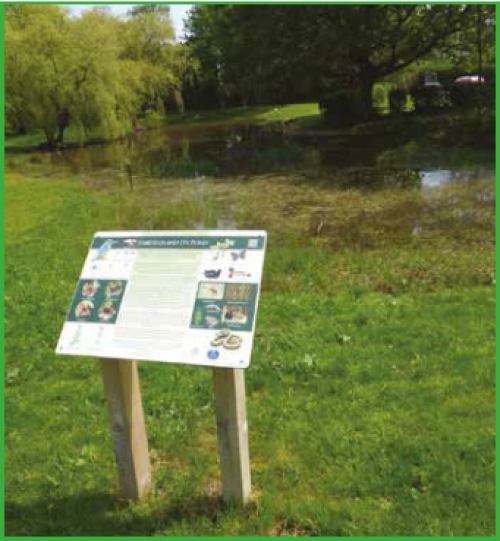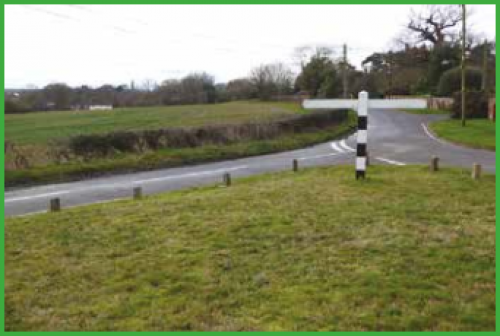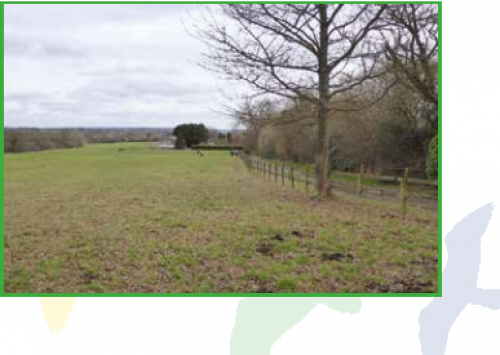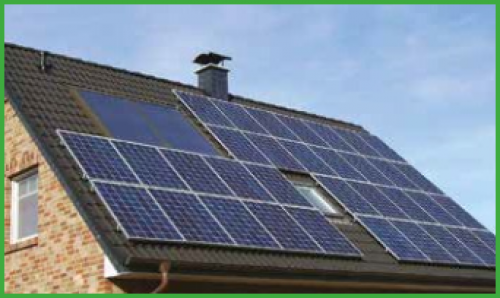Ingatestone & Fryerning Neighbourhood Plan Regulation 16
VISION AND OBJECTIVES
- To maintain and protect the natural environment and green space within the parish.
- To enhance the biodiversity of the parish.
- To reduce carbon emissions within the parish in order to combat climate change.
- To ensure all residents living within the parish breathe clean air.
CONTEXT
The parish has a strong rural character. The village of Ingatestone is surrounded by open and agricultural land which separates it from Fryerning to the north west and other nearby settlements of Mountnessing, Margaretting and Stock. Outside the villages of Ingatestone and Fryerning the parish consists of predominantly open countryside. Inside the village boundaries the largest areas of green infrastructure[28] and open space[29] are Fairfield Recreation Ground (Figure 15) and Seymour Field (Figure 16).
The parish contains areas of mature woodland at Mill Green, Fryerning Wood and College Wood and there are several small lakes primarily used for angling. Mill Green Common (Figure 17) is part of the ancient royal hunting forest known as Writtle Forest. Some parts of this area have changed little since the early medieval period.
There are 15 local wildlife sites (LWS) located throughout the parish[30], consisting predominantly of woodland areas. The woodland and open fields (Figure 18) provide good habitats for fauna and flora. There are large tracts of agricultural land, predominantly arable farming, which are listed as Grade 2 and Grade 3 agricultural land. Fields are separated by hedgerows which in themselves provide valuable habitats.
Protecting and maintaining the natural environment, open space and green infrastructure
The open countryside areas of the parish provide a variety of habitats for fauna and flora. Many species depend on the natural environment for food and shelter. Where human development impacts upon the ability of wildlife to survive we have a responsibility to current and future residents of the parish and beyond to protect our natural environment.
IFNP Environment Policy 6 aims to maintain and protect the natural environment from human impact, especially relating to new developments within the countryside on the edge of existing settlements. This approach reflects views identified through the IFNP residents questionnaire undertaken in summer 2018, which identified that features which residents considered most important for the area included proximity to countryside, an attractive village environment and public open space.

Figure 15: Fairfield pond
Account should be taken of Natural England's desire 'to leave our environment protected and enhanced for the future' (Defra 2018a).
Through policies and proposed projects in the IFNP, the parish council is seeking to enhance the natural environment within the parish. Where possible and appropriate, new development proposals should seek opportunities to create wildlife corridors and improve access to the countryside for recreation. Development proposals which will have an impact on the natural environment will be required to clearly demonstrate the potential impacts of development, preferably through an ecological assessment.
Where development proposals are likely to impact upon the natural environment, open space or green infrastructure, they will be required to clearly demonstrate how the benefits arising from the development will outweigh the negative impacts. Such benefits could include access to the countryside for recreation, creation of wildlife corridors, overall long-term net biodiversity gains and the achievement of other objectives set out in this plan.

Figure 16: Seymour Field. Copyright Forever Callie Ltd www.forevercallie.com
Where mitigation measures are required to support new development, the parish council may consider a 'like for like' replacement, relocation and/or compensation towards the loss of habitats where it can be demonstrated that such measures will result in a net biodiversity gain for the area and improvements to habitats in relation to quantity, quality and connectivity. Any compensatory habitat created should be delivered as close as possible to the development site and should be ecologically functional in advance of any loss. Account should be taken by developers of the Recreational Disturbance Avoidance & Mitigation Strategy (RAMS) as this impacts the parish.
IFNP questionnaire results identified that local residents would prefer new development to be located on previously developed land to protect undeveloped countryside areas and local wildlife habitats. Open space within the village of Ingatestone is limited.

Figure 17: Church Green

Figure 18: Fryerning open field

Figure 19: Solar panel
Public access is limited to Fairfield Recreation Ground and Seymour Field. It is imperative that these areas are maintained and where possible enhanced, not only for recreational and sporting activities as outlined, but also to provide habitats to local flora and fauna.
Climate change
The parish will face environmental challenges over the next 30 years. The Climate Change Act 2008 first committed the UK to drastically reduce its carbon emissions by 2050. However, recent studies, including work undertaken by the United Nations International Panel on Climate Change (IPCC), suggest we need to decarbonise by 2030 to have a meaningful impact on the effect of climate change.
At the international level the Paris Agreement commits the UK to 'keeping global average temperatures 'well below' two degrees centigrade above pre-industrial levels'. As a result, Policy 6 seeks to encourage development proposals which mitigate against climate change and promote adaption. Climate change is a cross cutting theme, therefore sustainability and resilience is embedded throughout the IFNP.
Improving the energy efficiency of buildings within the parish will provide an important contribution towards reducing carbon emissions within the parish. While IFNP Housing Design Policy 2, seeks to encourage sustainable design features within new developments, this will only influence a small proportion of the total buildings in the parish. To reduce carbon emissions in the parish, it is therefore essential that we seek to encourage and support improvements to the energy efficiency of existing buildings within the parish.
Encouraging the use of sustainable modes of transport[31] will also support a reduction in carbon emissions within the parish. IFNP Transport Policy 5, presents policies and projects to encourage the use of sustainable modes of transport. In addition to encouraging sustainable modes of transport, electric vehicles will also provide an opportunity to reduce carbon emissions and air pollution. The inclusion of electric vehicle charging points within new developments will therefore be supported and encouraged, or as a minimum infrastructure to support the provision of charging points in the future should be provided. This could include for example electric cabling adjacent to car parking spaces and sufficient space adjacent to the parking bay to provide a charging point.
To support the environment the parish council will seek opportunities to plant new trees within the parish and will encourage new developments to include new tree planting.
Extreme weather and flooding
It is predicted that climate change will result in more extreme weather events. With increased rainfall comes the increased risk of flooding. Longer heat waves may also affect water supplies.
In several locations in the parish roads flood after heavy rainfall and drains are often blocked. The main area of flooding is farmland adjacent to the River Wid.
New developments should promote water efficiency by incorporating rainfall harvesting technology. Tree planting will also be encouraged to improve water infiltration levels within new developments. Sustainable urban drainage systems should be included within new development proposals which include new houses.
Renewable energy
Government has set a target to deliver 15% of UK energy consumption by renewable means by 2020. The costs of installing solar (Figure 19) and wind energy have fallen dramatically in recent years and therefore provides an opportunity for more renewable energy to be produced locally. The parish council will work with the local community through the establishment of a Community Energy Group to consider where and how renewable energy developments could be provided within the parish and to produce a Sustainable Energy Plan for the parish.
Noise and air pollution
In recent years evidence has been produced demonstrating the serious health consequences of air pollution. BBC no longer monitors air pollution within the parish. Where no monitoring is taking place, it is unclear if there are any air quality issues which need to be addressed within the parish. This is an issue of concern for local residents, particularly due to the location of the Ingatestone Infant and Ingatestone Junior Schools close to the A12.
The parish council will consult with BBC to consider options for air quality monitoring within the parish on Ingatestone High Street and close to Ingatestone Infant School on Fryerning Lane. In the absence of any regular monitoring, all new major developments (10 dwellings or more[32]) in the parish will be required to demonstrate an understanding of the current air quality surrounding the development site and outline the potential wider air quality implications of the proposed development on the parish.
Development proposals should protect and where possible enhance, the natural environment. All development proposals should seek to deliver net biodiversity gain, in addition to protecting existing habitats and species. Any proposals which negatively affect, or have the potential to negatively affect, the natural environment should demonstrate that any negative impacts on biodiversity, including flora, fauna and wildlife habitats, will be adequately mitigated.
Development proposals which may have an impact on wildlife habitats in the parish should be accompanied by an ecological assessment which will clearly demonstrate any potential impacts.
Development proposals will be encouraged that seek to enhance the provision of and access to, green infrastructure and open space in the parish by:
- Creating new areas of green infrastructure and open space.
- Improving the connectivity between wildlife habitat areas and green infrastructure and open space through wildlife corridors and / or improvements to the Public Rights of Way and cycle, bridleway and footpath networks.
- Enhancing the visual characteristics and biodiversity of green infrastructure and open space in close proximity to new development.
Development proposals which would result in the net loss of green infrastructure or areas of open space will only be supported where it can be demonstrated that:
- The benefits of the project outweigh any identified harm created by the loss.
- Overall the development results in a net biodiversity gain for the area and improvements to habitats in relation to quantity, quality and connectivity.
- Any compensatory wildlife habitat is created as close as possible to the development site and should be ecologically functional in advance of any loss.
New development proposals should seek opportunities to reduce carbon emissions by:
- Encouraging the use of sustainable modes of transport within the design of developments through safe walking and cycling routes which provide connections to surrounding public transport and local services and facilities.
- Encouraging home working by designing homes to be adaptable and ensuring good quality mobile phone and broadband connections.
- Seeking new tree planting within new development schemes in the parish.
- Providing electric car charging points within new developments, or as a minimum ensuring essential infrastructure is in place to enable charging points to be provided in the future.
- Incorporating sustainable design features which promote energy efficiency, biodiversity gains, innovative low carbon technology, water efficiency, energy conservation and efficiency, flood resilience, sustainable waste and mineral management. Management, such as infiltration, interception, rainwater harvesting, and grey water recycling, which include source control features such as permeable paving, water butts, rain gardens, green roofs, and site control features such as swales, ponds and detention basins.
New development proposals should incorporate Sustainable Drainage Systems (SuDS) where appropriate to manage rates of surface water runoff and to reduce the potential for flooding. Sustainable Drainage Systems should also be used to enhance biodiversity and eco systems within development proposals.
Proposals for new development should not detrimentally impact air quality and public health within the parish as a result of increased traffic flows and congestion. All major development proposals will be required to contribute towards the provision of air quality monitoring to demonstrate an understanding of the current air quality surrounding the development site and outline the potential wider air quality implications of the proposed development on the parish.
- The frequent flooding of the River Wid should be addressed by Brentwood Borough Council and Chelmsford City Council jointly as an s106/CIL device.
Relevant evidence base documents:
Town and Country Planning (Development Management Procedure) (England) Order 2015.
[28] Green infrastructure is a network of multifunctional green spaces in rural and urban areas, which supports natural ecological processes to deliver a range of environmental and quality of life benefits that are integral to successful sustainable communities.
[29] Open space relates to all spaces of public value, including land and areas of water such as rivers and lakes (also referred to as blue infrastructure), which offer opportunities for sport and recreation and provide visual amenity.
[30] www.essexwtrecords.org.uk Natural England, Nature Network Evidence Handbook.
[31] Sustainable modes of transport are transport modes which do not rely on the car, such as walking and cycling and public transport such as buses and trains.
[32] Major developments as defined within the Town and Country Planning (Development Management Procedure) (England) Order 2015.
